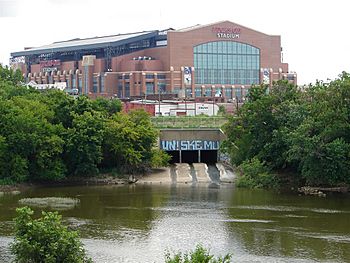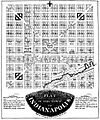Pogue's Run facts for kids
Quick facts for kids Pogue's Run |
|
|---|---|

Pogue's Run emptying into the White River southwest of Lucas Oil Stadium
|
|
| Physical characteristics | |
| Main source | Elizabeth Street and Lennington Drive, Indianapolis, Indiana, USA 849 ft (259 m) 39°49′40″N 86°03′03″W / 39.827856°N 86.050765°W |
| River mouth | White River south of the Kentucky Avenue bridge 675 ft (206 m) 39°45′22″N 86°10′20″W / 39.75619°N 86.17228°W |
| Length | 11 mi (18 km) |
| Basin features | |
| Basin size | 13 sq mi (34 km2) |
Pogue's Run is a small creek that flows through Indianapolis, Indiana. It starts on the east side of the city and ends in the White River. For a big part of its journey, especially under downtown Indianapolis, Pogue's Run flows through a hidden underground tunnel.
The creek is named after George Pogue. He was one of the first settlers in the area that later became the city of Indianapolis. Today, a walking path called the Pogue's Run Trail is being built along the creek's eastern part.
Contents
History of Pogue's Run
Before settlers arrived, Native Americans and animals often used Pogue's Run as a natural pathway. George Pogue, a blacksmith, came to the area in 1819. He built a cabin for his family near where Michigan Street now crosses the creek.
However, some historians disagree on the exact details. One historian, Jacob Piatt Dunn, wrote that Pogue arrived in 1820. He said Pogue moved into a cabin that another person, Ute Perkins, had built in 1819. Perkins had left the area before Pogue arrived.
The creek became known as Pogue's Run after George Pogue disappeared in April 1821. Before that, it was sometimes called Perkin's Run, after Ute Perkins.
Laying Out Indianapolis
When the city of Indianapolis was being planned, Pogue's Run was a bit of a challenge. It ran diagonally across the southeast part of the "Mile Square" area. This made it hard to keep the city's grid pattern perfectly neat. Alexander Ralston, who designed the city, had to make changes because of the creek's path.
Before the state government moved to Indianapolis, money was spent to clean up Pogue's Run. The creek was swampy and full of mosquitoes, which made people sick.
Pogue's Run in the Civil War
During the American Civil War, a strange event happened near the creek on May 20, 1863. It's called the Battle of Pogue's Run. Some members of the Democratic Party were leaving a meeting. Union soldiers were searching for illegal weapons. To avoid being caught, many people threw their guns and knives into Pogue's Run.
Later, in 1882, the creek flooded badly. This flood caused at least ten deaths. A covered bridge that once crossed Pogue's Run was also destroyed by the flood.
Hiding the Creek Underground
Between 1914 and 1915, a big project covered Pogue's Run. The creek was put into a large underground tunnel beneath downtown Indianapolis. This project cost over a million dollars.
Several reasons led to this decision:
- The creek often flooded, causing damage and danger.
- It was a health risk because of diseases carried by mosquitoes.
- The creek smelled bad because of pollution from sewage and factories.
Covering the creek also helped with railroad tracks. It made it easier to raise the tracks, which helped reduce traffic jams on Indianapolis roads.
Just northeast of downtown, Brookside Park was built. This park used the creek area for fun activities and recreation.
Pogue's Run Today
Indy Parks has started building the Pogue's Run Trail along the creek. This trail is located northeast of downtown. Plans are in place to extend the trail to connect it with downtown Indianapolis.
As of August 2020, about 2 miles of the planned 5.3-mile trail are finished. The trail will eventually go from the Monon Trail to the Pogues Run Art and Nature Park.
A big challenge for finishing the trail is the Nowland Avenue bridge. This bridge, built in 1909, crosses Pogue's Run and connects Spades Park and Brookside Park. It is currently closed because it's in bad shape. This bridge is a historic landmark and part of the Indianapolis Park and Boulevard System. Local groups are working hard to fix the bridge and complete the trail.
Wildlife Along the Creek
You can see different animals along the path next to Pogue's Run. These include ducks, geese, and red-winged blackbirds. Sometimes, you might even spot herons. One small problem for people walking the trail is goose droppings.
Charting Pogue's Run
A project called "Charting Pogue's Run" shows where the creek used to flow downtown. A blue line, made of steel markers and a temporary blue line, winds across streets and parking lots. This blue line shows that Pogue's Run now flows underneath places like Lucas Oil Stadium and Bankers Life Fieldfieldhouse.
Pogue's Run in Books and Movies
The underground part of Pogue's Run has appeared in popular culture:
- The movie Twice Under (1987) was partly filmed in the hidden tunnels of Pogue's Run.
- It is an important setting in Ben Winters' 2016 book, Underground Airlines.
- The creek is also featured in John Green's 2017 book, Turtles All the Way Down.
Images for kids


